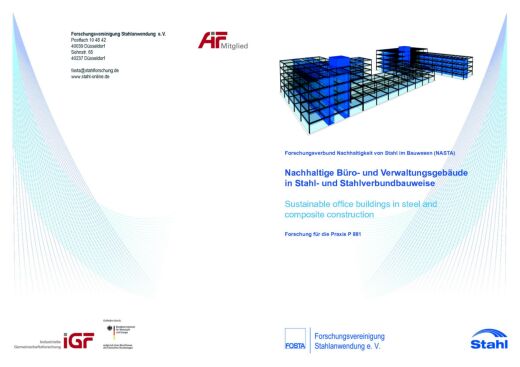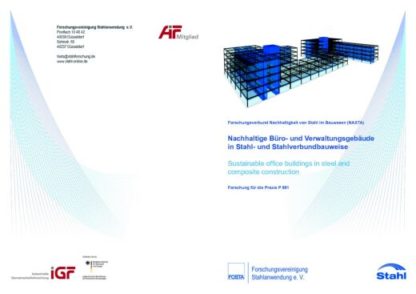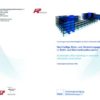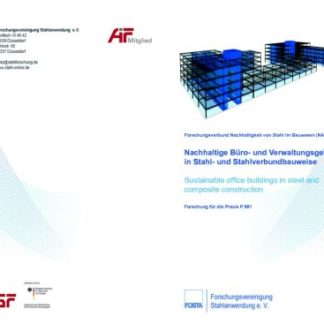Description
P 881 – Sustainable office buildings in steel and composite construction
Life-cycle-orientated observation of structural design via integrated planning facilitates access to significant monetary and ecological savings potential, making this approach preferable to sequential observations with a focus on production and operating costs. The potential for influencing sustainability in office and administration buildings is greatest during initiation and design phases; optimization during later planning and construction phases can only be leveraged to a lesser extent.
Thus, the objective of this research project has been to establish foundations for yielding instruments, such as a handbook featuring planning guidelines and aids, as well as software tools to promote ecological, economical, and social sustainability in planning office and administration buildings during conceptualization and design phases. The goal has been to minimize environmental effects and to maximize functional and social qualities with simultaneous optimization in both production costs and subsequent expenditures.
Building structures (ceiling systems, pillars, walls, bracing elements, and building façades) are assessed with regard to production, maintenance, options and expenditures for structural modification, removal, and recycling potential (building material and component recycling). The focus here is on steel and composite structures, with the three aspects of ecological, economical, and social-technological quality taken into account in equal measure.
This report lay out the findings from analysis and development work carried out via investigations into the necessity of more flexibility in building design from a social-technological and economical perspective. Design and function specifications, conditions at the respective site, and urban integration requirements have been studied in order to develop recommendations for ground floor layouts, heights, utilizations in various specification profiles, as well as positioning in pillars, walls, and bracing cores. Following a description of the various structural forms and elements the report compiles technical requirements for loadbearing structures as regards assessment and design. A detailed presentation of the assessment method applied and its normative foundations follows, as well as an assessment of the ecological and economical sustainability of load-bearing structures. To that end, investigations are performed into the various construction methods, grid dimensions, concrete and steel grades, and element designs. Load-bearing structures consisting of various components are evaluated, starting with individual construction elements such as ceiling types, brace and support structures. Sustainability analyses on various potential solutions performed during the design phase require high performance planning tools permitting quick comparison of construction variants. The foundation here consists of catalogues for selecting construction systems and the associated components, as found in the attachments to the report. With the aid of the component catalogues for system variants created within the scope of the research project, The report proposes recommendations for component dimensioning as well as for the selection of suitable construction forms and materials. Furthermore information with investigations and further recommendations on sustainable execution of façades on office buildings are given. The SketchUp Plugin “Structural Office Designer SOD” developed during the project enables comparison of variants in the early design phase with regard to eco-balancing on a steel or composite structure. In a matter of just a few seconds, this intuitive software based on evolutionary methods will optimize the load-bearing structure on steel composite structures for standard office buildings, providing architects and engineers with all key information as regards geometry and materialization of a load-bearing structure. This tool makes it possible to yield detailed information right in the early design phases for sustainable building execution.
In order to attain the highest possible level of acceptance in practice, these planning aids facilitate adaptive application. That means the recommendations in the various design phases can be accepted or modified, or even changed via the user’s own definitions. The instruments developed within the project should be exclusively interpreted as aids for the planners involved in the design process, as they need to provide targeted, efficient support in planning sustainable steel and composite buildings. There is no intention to restrict room for manoeuvre in designing and decision-making due to a rigid “sustainability corset.”
The research report comprehensively presents the project’s scientific findings, furthermore laying out the background to the SketchUp plugin “Structural Office Designer,” the component catalogue, and the resulting project handbook. The attachments to the report consist of important calculations and data, the component catalogue, as well as corresponding supplemental in-formation.
The research project (IGF-Nr. 16586 N) was carried out at Lehrstuhl für Metallbau, Technische Universität München, at Institut für Stahl- und Holzbau, Technische Universität Dresden, at Lehrstuhl für Stahlbau und Leichtmetallbau, RWTH Aachen, im Fachgebiet Entwerfen und Baugestaltung, Technische Universität Darmstadt, at Institut für Technologie und Arbeit e.V., Kaiserslautern and at Lehrstuhl für Unternehmensrechnung und Controlling, Technische Universität Kaiserslautern. FOSTA has accompanied the research project work and has organized the project funding from the Federal Ministry of Economics and Technology through the AiF as part of the programme for promoting industrial cooperation research (IGF) in accordance with a resolution of the German parliament.
Only available in german language.
Published in:
2016
Authors:
M. Mensinger, H. Möller, L. Huang, F. Ritter, R. Stroetmann, C. Podgorski, J. Scheller, T. Faßl, M. Feldmann, D. Pyschny, F. Lang, B. Trautmann, K. J. Zink, T. Baudach, K. Fischer, V. Lingnau, K. Kokot




